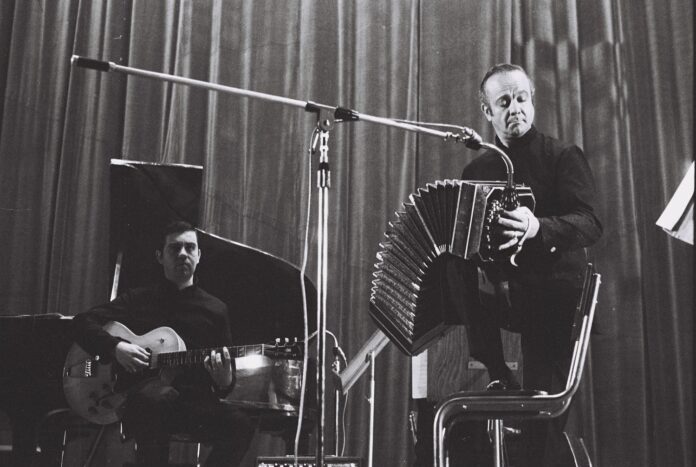L’11 marzo 1921 nasceva, a Mar del Plata, Astor Pantaleón Piazzolla, il sinfonista del tango, detto “el Gato”, per via del talento fulmineo e divergente, dal bandoneonista Aníbal Troilo, detto “Pichuco” e “el gordo”, un grande con cui Astor suonò.
Ricordando Astor Piazzolla
Le celebrazioni per Piazzolla, scomparso a Buenos Aires nel 1992, sono un atto dovuto, pur nelle difficoltà quasi insormontabili che il tango, con il suo abbraccio, deve scontare.
Uscirà in primavera anche in Italia, distribuito da EXIT Media, un film prezioso, Piazzolla, los años del tiburón/The Years of Shark (2018), un ritratto curato dal figlio Daniel, che fa emergere aspetti sottaciuti nella vicenda del maestro che ha innovato in profondità la musica urbana argentina.
Si sa che Piazzolla studiò a Parigi con Nadia Boulanger, madrina di tanta avanguardia colta, e si sa che la sua musica non piaceva a Jorge Luis Borges, per cui il tango era solo quello ruspante delle periferie e dei malavitosi con i coltelli.
Sia Borges che Piazzola, per altro, sono stati accusati di complicità con la dittatura di Videla, in una delle fasi crudeli della storia del loro Paese.
Le influenze newyorkesi
Ma non si sa molto invece del periodo in cui, con i genitori, Piazzolla visse a New York fino all’età di sedici anni, influenzato dalla musica americana, popolare, rock e jazz.
Sotto la lente dell’affettuosa regia di Daniel Rosenfeld, il film è costruito con preziosi filmati d’epoca, dove appaiono Carlos Gardel, “el ruiseñor”, l’usignolo del tango, Arthur Rubinstein, Alberto Ginastera, Armande Boulanger e Gerry Mulligan, e illumina il periodo newyorkese, che Piazzolla stesso definisce fondante nel suo percorso creativo.
Ma fa emergere anche un carattere a contropelo, con scelte contro-corrente, nel suo dar vita a un tango diverso,“poco ballabile”, che pure farà scuola poi a generazioni di musicisti del “tango nuevo”.
Come si compone il documentario
Daniel Piazzolla, che ebbe una relazione non facile con il padre, ha aperto a Rosenfeld le porte della sua collezione privata, ritrovando brani di esibizioni dal vivo e di filmati familiari per dar vita a un ritratto sfaccettato di Piazzolla: sicuro di sé, caparbio, appassionato, ruvido.
Le registrazioni di ore di conversazione tra Piazzolla e sua figlia Diana evocano da un’angolazione intima il profilo inedito di un genio musicale.
Il documentario non è un tributo, ma uno scavo intenso in tanti materiali audio, video e fotografici, compresi i filmini super 8.
Il titolo nasce dalla passione per la pesca del musicista – il padre “nonino” era un pescatore immigrato dalla Puglia – e il racconto è imbevuto dell’amore-odio per la sua Argentina, travagliata e meravigliosa.
Astor Pantaleón Piazzolla was born on the 11 March 1921, in Mar del Plata. He was the tango symphonist, called “el Gato” (because of the lightning-fast and divergent talent) by the bandoneonist Aníbal Troilo; and called “Pichuco” and “el gordo”, a great one with whom Astor played.
Remembering Astor Piazzolla
The celebrations for Piazzolla, who disappeared in Buenos Aires in 1992, are a duty, that despite the almost insurmountable difficulties that the tango, with its embrace, must face.
It will be released this spring, also in Italy, distributed by EXIT MEDIA, a precious film, Piazzolla, los años del tiburón/The Years of Shark (2018), a portrait edited by his son Daniel, which brings out unspoken aspects in the story of the master who deeply innovated Argentine urban music.
It is known that Piazzolla studied in Paris with Nadia Boulanger, godmother of such cultured avant-garde, and it is known that his music was not liked by Jorge Luis Borges, for which tango was only the free-flowing from the suburbs and of the mobsters with knives.
Both Borges and Piazzolla, moreover, were accused of complicity with the Videla dictatorship, in one of the cruel phases of their country’s history.
New York Influences
But, instead, we don’t know much about the period in which Piazzolla lived in New York with his parents, until the age of sixteen, and was influenced by American music, popular music, rock and jazz.
Under the lens of Daniel Rosenfeld‘s affectionate direction, the film is built with precious period films, with appearances of Carlos Gardel, “el ruiseñor”, the nightingale of the tango, Arthur Rubinstein, Alberto Ginastera, Armande Boulanger and Gerry Mulligan. It illuminates the New York period, that Piazzolla himself defined as fundamental in his creative path.
But, it also brings out a counter-grain character, with counter-current choices, in his giving life to a different tango, ‘not much danceable’, which will also teach generations of “tango nuevo” musicians.
How the documentary is composed
Daniel Piazzolla, who had an uneasy relationship with his father, opened the doors of his private collection in Rosenfeld, finding excerpts of live performances and of familiar films to give life to a multifaceted portrait of Piazzolla: self-confident, stubborn, passionate, rough.
Recordings of hours of conversation between Piazzolla and his daughter Diana evoke, from an intimate angle, the unpublished profile of a musical genius.
The documentary is not a tribute, but an in-depth view of so many audio materials, video and photography, including super 8 movies.
The title comes from the musician’s passion for fishing, his father “nonino” was an immigrant fisherman from Puglia; and the story is imbued with love-hate for his Argentina, troubled and wonderful.








